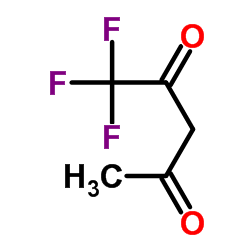Structure and vibrational assignment of the enol form of 1,1,1-trifluoro-2,4-pentanedione.
Mansoureh Zahedi-Tabrizi, Fariba Tayyari, Zainab Moosavi-Tekyeh, Alireza Jalali, Sayyed Faramarz Tayyari
文献索引:Spectrochim. Acta. A. Mol. Biomol. Spectrosc. 65(2) , 387-96, (2006)
全文:HTML全文
摘要
Molecular structure of 1,1,1-trifluoro-pentane-2,4-dione, known as trifluoro-acetylacetone (TFAA), has been investigated by means of Density Functional Theory (DFT) calculations and the results were compared with those of acetylacetone (AA) and hexafluoro-acetylacetone (HFAA). The harmonic vibrational frequencies of both stable cis-enol forms were calculated at B3LYP level of theory using 6-31G** and 6-311++G** basis sets. We also calculated the anharmonic frequencies at B3LYP/6-31G** level of theory for both stable cis-enol isomers. The calculated frequencies, Raman and IR intensities, and depolarization ratios were compared with the experimental results. The energy difference between the two stable cis-enol forms, calculated at B3LYP/6-311++G**, is only 5.89 kJ/mol. The observed vibrational frequencies and Raman and IR intensities are in excellent agreement with the corresponding values calculated for the most stable conformation, 2TFAA. According to the theoretical calculations, the hydrogen bond strength for the most stable conformer is 57 kJ/mol, about 9.5kJ/mol less than that of AA and about 14.5 kJ/mol more than that of HFAA. These hydrogen bond strengths are consistent with the frequency shifts for OH/OD stretching and OH/OD out-of-plane bending modes upon substitution of CH(3) groups with CF(3) groups. By comparing the vibrational spectra of both theoretical and experimental data, it was concluded that 2TFAA is the dominant isomer.
相关化合物
| 结构式 | 名称/CAS号 | 分子式 | 全部文献 |
|---|---|---|---|
 |
1,1,1-三氟乙酰丙酮
CAS:367-57-7 |
C5H5F3O2 |
|
Inhibition by diacylmethane derivatives of mutagenicity in S...
1991-03-01 [Mutat. Res. 262(3) , 189-93, (1991)] |
|
Inhibition by diacylmethane derivatives of mutagenicity and ...
1989-11-15 [J. Natl. Cancer Inst. 81(22) , 1743-7, (1989)] |
|
Synthesis and anticancer activity evaluation of new 2-alkylc...
2004-07-01 [Bioorg. Med. Chem. 12(13) , 3711-21, (2004)] |
|
Synthesis, Characterization, Spectral Studies, Antibacterial...
2015-01-01 [Acta Chim. Slov. 62 , 805-17, (2015)] |
|
Capillary gas chromatographic determination of putrescine an...
1999-02-19 [J. Chromatogr. B. Biomed. Sci. Appl. 723(1-2) , 17-24, (1999)] |